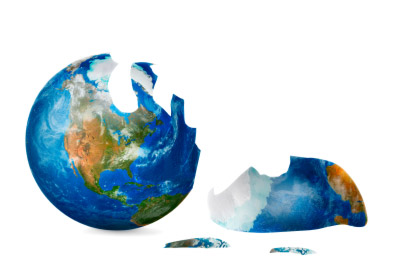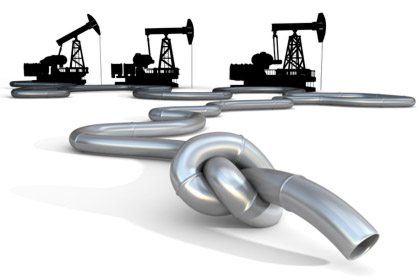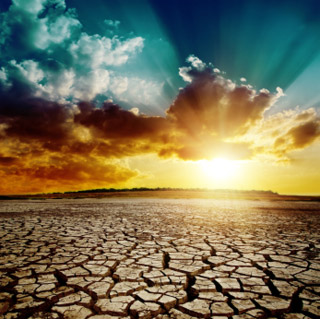The Crash of the Industrial Age
What if it were too late to save the world? What if rising threats to natural support systems on which all life depend, posed by humanity’s industrial way of life, have already done so much damage that collapse of the global industrial economy is inevitable? If so, it is no longer possible to save everybody from the awful consequences. Yet, it remains possible for any individual, family or community that immediately and thoroughly adopts sustainable living practices to weather even a civilizational collapse. Anyone who undertook such a difficult course would, of course, first have to be convinced the danger is real. The gravity of the situation is hard to appraise because negative effects of industrial practices are not publicly discussed, let alone dealt with. This is primarily because industries doing the damage are making a great deal of money while doing so. In order to keep the status quo, they freely spend money on political influence and propaganda designed to distract people from the fact that they are taking profits for themselves and leaving consequences for others. Another reason for lack of comprehension is experts’ narrow field of view. Researchers who grapple with specialized problems of increasing complexity seldom look up, or across, to see what is going on in other experts’ bore holes. But, when a generalist surveys the field and puts expert analyses side-by-side, the magnitude of the danger becomes apparent.
A generalist consulting a specialist about the state of civilization support systems needs to know what motivates the specialist. For instance, when the housing bubble was in mid-collapse in 2007, realtors were not a reliable source of information on the state or future of the market. (During virtually every day of the years’ long collapse, some realtors’ association announced the worst was over, the bottom had been found, and happy days were here again.) Another example is “fracking.” To find out whether hydraulic fracturing of shale gas is dangerous, do not ask a university receiving major funding from companies that practice fracturing. As Upton Sinclair put it, “It is difficult to get a man to understand something when his salary depends upon his not understanding it.”
Therefore, a survey of specialists whose salaries do not require lack of comprehension reveals a stunning array of injuries and stresses on the natural world – many planetary in scale and existential in nature. Global climate change is only one of them and not necessarily the most immediately dangerous. A review of the top three threats, more or less in descending order of urgency, may help form a decision about taking drastic personal action.
Threat #1: Humanity is Running Out of Oil
Nothing about modern life is possible unless oil and gas are both plentiful and cheap. And nothing is more remarkable about modern life than the fact that people know oil is finite, yet they continue to live as if it is inexhaustible. The United States burns roughly 20 million barrels of oil per day – one-quarter of the world’s consumption by less than five percent of the world’s population – but produces only eight to 10 million barrels per day (depending on what the meaning of “oil” is, and that is a moving target). In 2011, the world brought to market 87 million barrels of oil per day and consumed 88 million per day.1

© iStockphoto.com/Inok
M. King Hubbert was one of those rare people who could see truth even when his paycheck required him not to. He was a Shell Oil geologist in the 1950s when he grasped a truth about oil wells that also applied to oil fields and the world’s oil supply. When first opened, a well’s production increases rapidly, reaches a plateau and then tails off just as quickly. If one graphs the output, s/he gets a vertical parabola, which is the trail of something that goes up like a rocket and comes down like a rock.
Hubbert’s Curve, as the graph is known, when applied to oil fields within the United States (not including, at the time, Alaska) indicated U.S. oil production would peak and begin an irreversible decline in 1970. Reaction at the time ranged from incomprehension to derision, especially after the 1968 discovery of Alaska’s Prudhoe Bay oil field (never mind that Hubbert’s calculation was for the lower 48 states). Nevertheless, U.S. oil production, including Alaska’s, did in fact reach its highest volume in 1970 and has been declining since.
If Hubbert’s Curve is a correct depiction of the world’s oil supply, it indicates maximum production levels have been reached and the long decline has already started. It is difficult to know exactly because companies and countries lie about how much oil they have found and how much they can extract from the ground. Companies lie to entice investors; countries lie to enhance their power and placate their citizens. What no one lies about is demand. As subsistence farmers in China and India become wage earners and, thus, consumers with disposable income, they want cars and all the other blessings cheap, plentiful oil provides. The day everybody realizes that oil supply has peaked but demand is still going up – in other words, not enough oil to go around – is the day “all hell breaks loose.”
Hydraulic fracturing is occurring in 32 states and has opened large fields of shale-bound oil in Texas, Montana and North Dakota, as well as natural gas in Wyoming and Pennsylvania. Known as “fracking,” this process utilizes the application of water and chemicals under extremely high pressure deep underground to release oil and gas from shale. Propaganda about these advances (generated primarily to attract investors) has been so successful that the public and media have largely accepted the notion that an oil and gas renaissance is underway in America. This scenario has, seemingly, repealed Hubbert’s Curve, obviated peak oil and is leading the Nation toward energy independence.
Alas, Hubbert’s mathematics has not been repealed, and the fracking craze conveys that Americans are approaching energy independence in the same way that, when walking, people approach the horizon. Fracking wells, it turns out, is more expensive, less productive, and the process plays out sooner than anyone expected.2 Operations are hampered by daunting problems of water supply3 and water pollution. Each well uses three to five million gallons of water and, once deployed, the water is a witches’ brew of toxic chemicals that have to go somewhere.
In the case of natural gas, the initial success glutted the U.S. market and pushed retail prices to below one-half the cost of production. As a result, the number of gas fracking rigs operating in the country has gone from 1,600 four years ago to 425 as of February 8, 2013.4 In Montana’s share of the Bakken shale-oil play, which is a few years older than the similar field in North Dakota, production skyrocketed to 100,000 barrels per day in 2006 but has since plummeted to slightly more than just one-half that amount.5
In 2013, the U.S. Geological Survey6 and Society of Petroleum Engineers7 carefully estimated the amount of natural gas and oil that can be wrested from American shale. Their conclusion: It will be in the area of 25 per cent of the amount touted by oil and gas industries. But, as the New York Times reported in 2011, many industry insiders never believed their own hype. It was what had to be said to keep investor money coming in. According to the Times, one analyst from IHS Drilling Data wrote in 2009: “The word in the world of independents [independent oil and gas producers] is that the shale plays are just giant Ponzi schemes and [that] the economics just don’t work.”8
The great American energy boom of 2012, when stripped of deceptive hyperbole, resembles the upward curve at the end of a ski jump. It doesn’t put the skier back on top of the mountain; it just injects a brief thrill into the last part of the fall. Wherever one looks in the world, oil is running out. Even Saudi Arabia has been unable to sustain production of substantially more than nine million barrels of oil per day since 2005, except for a brief period during the 2008 price spike.

© iStockphoto.com/cinoby
Analysis by global banking and insurance behemoth Citigroup9 finds Saudi Arabia may be unable to export any oil by 2030. (This report ignored declining production and made its stunning prediction based on the rising consumption of the Saudi population.)
Mexico, the third largest supplier of oil to the United States, is often lumped in with Canada and the United States to envision “North American energy independence.” But Mexico’s oil production peaked in 200810; it has fallen below three million barrels per day and continues to fall fast. As a result, the United States will soon have to depend even more on its number two supplier, Saudi Arabia. (See above.)
“Optimism is important for human progress, but that does not mean we should ignore what the numbers are telling us,” says Saadallah Al Fathi, a former top official of the Organization of Petroleum Exporting Countries (OPEC).
Threat #2: Humanity is Running Out of Food
Industrial agriculture requires cheap, plentiful oil for fuel. Multiple passes with large machines are required to sow, fertilize, spray pesticides and harvest. Synthetic fertilizer manufacture requires large amounts of heat, usually from natural gas. And, harvests must be transported to market. But even without any oil supply or further climate change disruption, industrial agriculture is doomed.
Beginning with the introduction of the plow, industrial agriculture has been increasingly profligate with the one thing it must have to grow any crop – healthy topsoil. To generations of modern growers, topsoil has been seen as just dirt, a factory floor on which food is made by the application of technology and chemistry. Only recently have scientists learned that soil is a complex, living organism whose health determines humanity’s own. Soil cannot survive industrial agriculture methods – plowing, discing, cultivating, rod-weeding, harrowing, spraying, fertilizing, irrigating, swathing and combining. And, when soil dies, it blows and washes away.
Jeremy Grantham manages Boston’s GMO Capital, one of the largest asset-management firms in the world. He has been warning investors for years that the days of abundant resources and falling prices are over forever. In other words, massive global industrialization benefits have played out, and the real price tag is coming due. In his fourth-quarter 2012 letter to investors13 he made these points:
- Five years ago humanity entered a chronic global food crisis – rising prices and falling reserves – that is going to continue and worsen;
- The dramatic increase in food supply required to support the projected 2050 world population cannot be realized because of water supply exhaustion, topsoil loss, increasing droughts and rising fuel and fertilizer costs;
- As the food crisis worsens, especially if it is accompanied by simultaneous fuel price increases, “risks of social collapse and global instability increase to a point where they probably become the major source of international confrontations. China is particularly concerned (even slightly desperate) about resource scarcity, especially food;”
- “The general public, media, financial markets and governments badly underestimate these risks.”
Around the world, reports, papers, analysts and activists are repeating and expanding upon these points. (People seldom hear about them because none are able to deploy the huge advertising and public-relations budgets of food and agriculture giants like Monsanto, Cargill and Archer Daniels Midland.) Evan Fraser, author of Empires of Food and geographer at Guelph University in Ontario, Canada, says: “For six of the last 11 years, the world has consumed more food than it has grown. We do not have any buffer and are running down reserves. Our stocks are very low, and if we have a dry winter and a poor rice harvest we could see a major food crisis across the board.”
Lester Brown, best known as founder of Worldwatch Institute and originator of the concept of sustainable development, predicts in his new book Full Planet, Empty Plates that steadily rising food prices will soon lead to political instability, spreading hunger and, unless governments act, a catastrophic breakdown in global food supply. He writes: “An unprecedented period of world food security has come to an end. The world has lost its safety cushions and is living from year to year. This is the new politics of food scarcity. We are moving into a new food era, one in which it is every country for itself.”14
Even the U.S. Department of Agriculture, long regarded as an enabler and cheerleader for industrial agriculture, is showing signs of awakening to the terrible danger. Its third annual Climate Assessment Report15, just released in draft form for public review, not only admits the existence of climate change but states flatly that within 25 years the cumulative effects of rising temperatures on agriculture will become “a threat to the security of the United States.”
Threat #3: Humanity is Running Out of Water
Recent droughts brought on by climate change are not necessarily the worst threat to dwindling water supplies. Reservoirs that supply major American cities, such as Atlanta’s Lake Lanier and Las Vegas’ Lake Meade, frequently dropped to critical levels long before the onset of the current drought. In 2007, metro Atlanta’s five million residents were notified they were within 90 days of running out of water. Providential rains saved them, that time.

© iStockphoto.com/mycola
People have known for decades that they have been drawing down aquifers – underground water reservoirs tapped by wells and the source of 90 percent of the world’s fresh water – at unsustainable rates. One of the most glaring examples is the Ogallala Aquifer, which underlies much of the mid-American breadbasket from north Texas to the Dakotas. For one-half century, industrial farmers have been irrigating their crops with enormous quantities of water pumped from the Ogallala and reducing its water level by up to five feet per year.
Users could be forgiven for such overconsumption 50 years ago before it was well understood that the Ogallala is fossil water deposited 10,000 years ago by the last Ice Age’s melting glaciers. This means the aquifer cannot be replaced until the end of the next Ice Age. (In non-drought years some surface water filters down and may replenish it at a rate of a fraction of an inch per year.) However, even now when it is widely known how irreplaceable the aquifer is, users continue to withdraw the water at more than 100 times the maximum rate of replenishment.
Another threat to American water supply is the age and disrepair of its cities’ industrial systems built (many at the dawn of the Industrial Age) to deliver drinking water and to treat and dispose of wastewater. At a recent Senate hearing, it was estimated that, on average, 25 percent of drinking water leaks from water system pipes before reaching the faucet. The bottom line: It will take $335 billion to resurrect water systems and $300 billion to fix sewer systems.16
Humanity is Running Out of Time
Other fields of inquiry yield similarly dire results, and many areas of synergy among them magnify these threats. For example, air pollution is acidifying lakes, rivers and oceans while farm runoff stimulates algae growth, both of which threaten aquatic life and, thus, food supply. Water shortages threaten energy supply because nuclear power plants, oil-fracking rigs and concentrated-solar farms all require huge amounts of water to operate. And, the granddaddy of all threat multipliers – global climate change – is coming on faster and harder than anyone predicted just a few years ago.
Humanity stands on the deck of a Titanic and is beguiled by blandishments of the all-you-can-eat buffet, lavish surroundings and a crew that murmurs constantly, “Nothing can go wrong.” Yet, the deck is tilting, water is pouring in below deck, and it doesn’t take a naval architect to conclude this ship cannot be saved. Yet, materials are at hand with which society could build a lifeboat. Anyone can choose to live sustainably, which means producing all the food, fiber and energy h/she consumes in a safe place (not in a city, desert or along the coast). It would be difficult; it would require hard work and hard choices, and there is no guarantee people could be ready in time. But, it may be the only legitimate hope in the face of a future darkening fast.




























